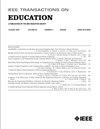An LLM-Driven Chatbot in Higher Education for Databases and Information Systems
IF 2
2区 工程技术
Q2 EDUCATION, SCIENTIFIC DISCIPLINES
引用次数: 0
Abstract
Contribution: This research explores the benefits and challenges of developing, deploying, and evaluating a large language model (LLM) chatbot, MoodleBot, in computer science classroom settings. It highlights the potential of integrating LLMs into LMSs like Moodle to support self-regulated learning (SRL) and help-seeking behavior. Background: Computer science educators face immense challenges incorporating novel tools into LMSs to create a supportive and engaging learning environment. MoodleBot addresses this challenge by offering an interactive platform for both students and teachers. Research Questions: Despite issues like bias, hallucinations, and teachers’ and educators’ resistance to embracing new (AI) technologies, this research investigates two questions: (RQ1) To what extent do students accept MoodleBot as a valuable tool for learning support? (RQ2) How accurately does MoodleBot churn out responses, and how congruent are these with the established course content? Methodology: This study reviews pedagogical literature on AI-driven chatbots and adopts the retrieval-augmented generation (RAG) approach for MoodleBot’s design and data processing. The technology acceptance model (TAM) evaluates user acceptance through constructs like perceived usefulness (PU) and Ease of Use. Forty-six students participated, with 30 completing the TAM questionnaire. Findings: LLM-based chatbots like MoodleBot can significantly improve the teaching and learning process. This study revealed a high accuracy rate (88%) in providing course-related assistance. Positive responses from students attest to the efficacy and applicability of AI-driven educational tools. These findings indicate that educational chatbots are suitable for integration into courses to improve personalized learning and reduce teacher administrative burden, although improvements in automated fact-checking are needed.高等教育数据库与信息系统中llm驱动的聊天机器人
贡献:本研究探讨了在计算机科学课堂环境中开发、部署和评估大型语言模型(LLM)聊天机器人MoodleBot的好处和挑战。它强调了将llm整合到像Moodle这样的lms中以支持自我调节学习(SRL)和寻求帮助行为的潜力。背景:计算机科学教育者面临着将新工具整合到lms中以创造一个支持性和参与性的学习环境的巨大挑战。MoodleBot通过为学生和教师提供一个互动平台来解决这一挑战。研究问题:尽管存在偏见、幻觉以及教师和教育工作者对采用新(人工智能)技术的抵制等问题,但本研究调查了两个问题:(RQ1)学生在多大程度上接受MoodleBot作为有价值的学习支持工具?(RQ2) MoodleBot给出的回答有多准确?这些回答与既定课程内容的一致性如何?方法:本研究回顾了人工智能驱动的聊天机器人的教学文献,并采用检索增强生成(RAG)方法进行MoodleBot的设计和数据处理。技术接受模型(TAM)通过感知有用性(PU)和易用性等结构来评估用户接受程度。46名学生参与,其中30名完成TAM问卷。研究结果:MoodleBot等基于法学硕士的聊天机器人可以显著改善教学过程。本研究显示,提供课程相关协助的准确率较高(88%)。学生的积极反应证明了人工智能驱动的教育工具的有效性和适用性。这些发现表明,教育聊天机器人适合整合到课程中,以改善个性化学习并减轻教师的行政负担,尽管需要改进自动事实核查。
本文章由计算机程序翻译,如有差异,请以英文原文为准。
求助全文
约1分钟内获得全文
求助全文
来源期刊

IEEE Transactions on Education
工程技术-工程:电子与电气
CiteScore
5.80
自引率
7.70%
发文量
90
审稿时长
1 months
期刊介绍:
The IEEE Transactions on Education (ToE) publishes significant and original scholarly contributions to education in electrical and electronics engineering, computer engineering, computer science, and other fields within the scope of interest of IEEE. Contributions must address discovery, integration, and/or application of knowledge in education in these fields. Articles must support contributions and assertions with compelling evidence and provide explicit, transparent descriptions of the processes through which the evidence is collected, analyzed, and interpreted. While characteristics of compelling evidence cannot be described to address every conceivable situation, generally assessment of the work being reported must go beyond student self-report and attitudinal data.
 求助内容:
求助内容: 应助结果提醒方式:
应助结果提醒方式:


